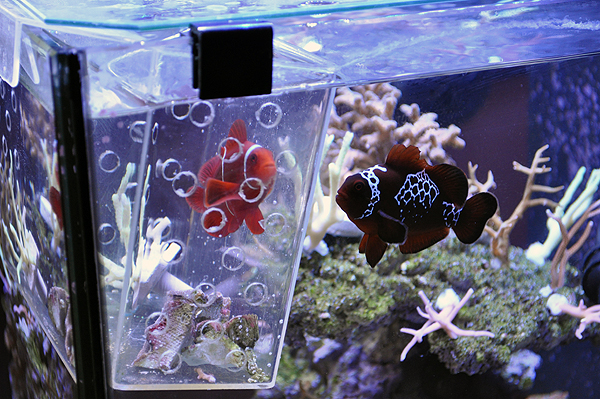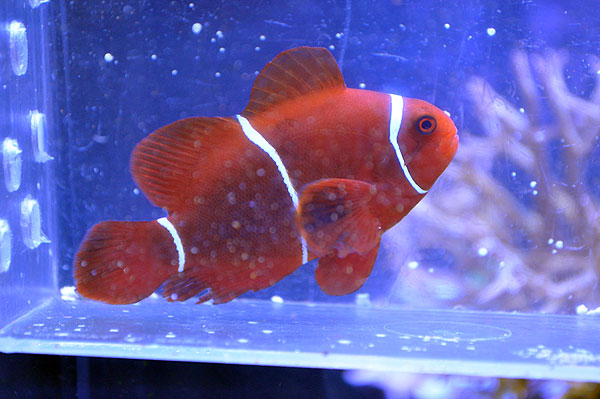As promised, finally, the process of pairing up the Lightning Maroon with a known male PNG Maroon is finally underway.

To put it bluntly, without a doubt I am convinced that for the last year, the Lightning Maroon has been male. Why? Well, first, watch this video of the female Gold Stripe Maroon that used to be paired with the White Stripe Maroon above. The new small Gold Stripe Maroon was introduced to the female Gold Stripe less than a minute before this video was taken. Watch the interactions.
Next up, here’s the Labrador Maroon, trying to be paired with a “female” White Stripe Maroon. The deal here – a local hobbyist thought this maroon to be female, and was trying to pair it with a smaller maroon. The two maroons fought incessantly, and this I believe was the second attempt (the first one ended up with a dead maroon). Both Maroons wound up in my possession.
I already paired the “male” with a larger White Stripe Maroon (you may recall Lucy, a lone wolf female living in a sump that Debbie in the twin cities contributed). The first go round it didn’t work so well, but after a week or two of living in a container, the male was released and all went well.
So the “female” meanwhile, has been living in another container in QT and was moved in with the Labrador in a container either Wednesday or Thursday this week. Unlike the interactions you’ll see with the Lightning Maroon, the Labrador didn’t show any interest in the maroon until it was released. And the “female” maroon certainly wasn’t acting like a female…scared to death perhaps, it instantly went into classic submissive behavior. Unfortunately, in all the commotion, the Dwarf Angels started attacking too, and ultimately, after 10 minutes, the “female” Maroon was returned to her container to “lick her wounds”.
Also tried pairing up the PNG “extras” today again. You may remember months ago I showed a video of the reaction – here it is from August 31st
And here is the same pair April 10th, 2011. I’ve been feeding the male in the “cage” only once per day, while the other fish gets feed at least 2-3 times per day. The size difference is starting to stack up, and you’ll notice how the interactions have “changed”.
Still, in the end, this pair isn’t ready…by the last video, the “female” has resorted to occasional pot shots directed at the “male”. I suspect that given more time, and a greater size difference, this should result in a stable pairing.
In ALL of the examples, the reactions have not been as violent as the initial reaction of the Lightning Maroon to the smaller PNG Maroon, which wasn’t even released into the tank but was held back in a drilled specimen cup.
Obviously this pairing isn’t a home run. It’s a relationship that’s going to need a lot of counseling and support. As I was headed to the NWRS / UPMMAS frag swap on Friday, I reminded Renee that the small, normally colored Maroon needed to be in the cup. Sometime on Saturday, she was feeding our 11th month old son when she heard some commotion in the tank behind her. She scrambled downstairs, grabbed the first nets she could find, and returned the small PNG Maroon to the specimen cup. In the span of 3 minutes, this is what the Lightning Maroon had done.

Once again, it goes without saying that everything goes wrong when you’re out of town! Thankfully Renee was quick witted and addressed the problem. Of course, Sunday evening I walked up to the tank and the little one jumped out of the cup again…the interactions I saw weren’t quite as bad perhaps. The little male PNG Maroon made all the conciliatory and submissive gestures, but the Lightning Maroon still is not a receptive mate. This is going to take a fair amount of time yet, and as most of you should realize by now, pairing up White Stripe Maroons is NOT easy.
- About The Lightning Project
- Inventory of F1 PNG Lightning and White Stripe Maroon Clownfish
- F1 PNG Lightning Maroon Clownfish, BZLM1
- F1 PNG Lightning Maroon Clownfish, BZLM2
- F1 PNG Lightning Maroon Clownfish, FW1
- F1 PNG Lightning Maroon Clownfish, LM10
- F1 PNG Lightning Maroon Clownfish, LM11
- F1 PNG Lightning Maroon Clownfish, LM12
- F1 PNG Lightning Maroon Clownfish, LM13
- F1 PNG Lightning Maroon Clownfish, LM14
- F1 PNG Lightning Maroon Clownfish, LM15
- F1 PNG Lightning Maroon Clownfish, LM16
- F1 PNG Lightning Maroon Clownfish, LM17
- F1 PNG Lightning Maroon Clownfish, LM18
- F1 PNG Lightning Maroon Clownfish, LM19
- F1 PNG Lightning Maroon Clownfish, LM20
- F1 PNG Lightning Maroon Clownfish, LM3
- F1 PNG Lightning Maroon Clownfish, LM4
- F1 PNG Lightning Maroon Clownfish, LM5
- F1 PNG Lightning Maroon Clownfish, LM6
- F1 PNG Lightning Maroon Clownfish, LM7
- F1 PNG Lightning Maroon Clownfish, LM8
- F1 PNG Lightning Maroon Clownfish, LM9
- F1 PNG Lightning Maroon Clownfish, MD1
- F1 PNG Lightning Maroon Clownfish, MWP3
- F1 PNG Lightning Maroon Clownfish, WS17
- F1 PNG Lightning Maroon, EC1
- F1 PNG Lightning Maroon, GL1
- F1 PNG White Stripe Maroon Clownfish, BZWS1
- F1 PNG White Stripe Maroon Clownfish, BZWS2
- F1 PNG White Stripe Maroon Clownfish, BZWS3
- F1 PNG White Stripe Maroon Clownfish, WS10
- F1 PNG White Stripe Maroon Clownfish, WS11
- F1 PNG White Stripe Maroon Clownfish, WS12
- F1 PNG White Stripe Maroon Clownfish, WS13
- F1 PNG White Stripe Maroon Clownfish, WS14
- F1 PNG White Stripe Maroon Clownfish, WS15
- F1 PNG White Stripe Maroon Clownfish, WS16
- F1 PNG White Stripe Maroon Clownfish, WS4
- F1 PNG White Stripe Maroon Clownfish, WS5
- F1 PNG White Stripe Maroon Clownfish, WS6
- F1 PNG White Stripe Maroon Clownfish, WS7
- F1 PNG White Stripe Maroon Clownfish, WS8
- F1 PNG White Stripe Maroon Clownfish, WS9
- F1 PNG White Stripe Maroon, EC2
- F1 PNG White Stripe Maroon, FW2
- F1 PNG White Stripe Maroon, GL2
- F1 PNG White Stripe Maroon, MD2
- Lightning Breeding Directive
- Lightning Maroon Clownfish Links
- Home
- About The Lightning Project
- Inventory of F1 PNG Lightning and White Stripe Maroon Clownfish
- F1 PNG Lightning Maroon Clownfish, BZLM1
- F1 PNG Lightning Maroon Clownfish, BZLM2
- F1 PNG Lightning Maroon Clownfish, FW1
- F1 PNG Lightning Maroon Clownfish, LM10
- F1 PNG Lightning Maroon Clownfish, LM11
- F1 PNG Lightning Maroon Clownfish, LM12
- F1 PNG Lightning Maroon Clownfish, LM13
- F1 PNG Lightning Maroon Clownfish, LM14
- F1 PNG Lightning Maroon Clownfish, LM15
- F1 PNG Lightning Maroon Clownfish, LM16
- F1 PNG Lightning Maroon Clownfish, LM17
- F1 PNG Lightning Maroon Clownfish, LM18
- F1 PNG Lightning Maroon Clownfish, LM19
- F1 PNG Lightning Maroon Clownfish, LM20
- F1 PNG Lightning Maroon Clownfish, LM3
- F1 PNG Lightning Maroon Clownfish, LM4
- F1 PNG Lightning Maroon Clownfish, LM5
- F1 PNG Lightning Maroon Clownfish, LM6
- F1 PNG Lightning Maroon Clownfish, LM7
- F1 PNG Lightning Maroon Clownfish, LM8
- F1 PNG Lightning Maroon Clownfish, LM9
- F1 PNG Lightning Maroon Clownfish, MD1
- F1 PNG Lightning Maroon Clownfish, MWP3
- F1 PNG Lightning Maroon Clownfish, WS17
- F1 PNG Lightning Maroon, EC1
- F1 PNG Lightning Maroon, GL1
- F1 PNG White Stripe Maroon Clownfish, BZWS1
- F1 PNG White Stripe Maroon Clownfish, BZWS2
- F1 PNG White Stripe Maroon Clownfish, BZWS3
- F1 PNG White Stripe Maroon Clownfish, WS10
- F1 PNG White Stripe Maroon Clownfish, WS11
- F1 PNG White Stripe Maroon Clownfish, WS12
- F1 PNG White Stripe Maroon Clownfish, WS13
- F1 PNG White Stripe Maroon Clownfish, WS14
- F1 PNG White Stripe Maroon Clownfish, WS15
- F1 PNG White Stripe Maroon Clownfish, WS16
- F1 PNG White Stripe Maroon Clownfish, WS4
- F1 PNG White Stripe Maroon Clownfish, WS5
- F1 PNG White Stripe Maroon Clownfish, WS6
- F1 PNG White Stripe Maroon Clownfish, WS7
- F1 PNG White Stripe Maroon Clownfish, WS8
- F1 PNG White Stripe Maroon Clownfish, WS9
- F1 PNG White Stripe Maroon, EC2
- F1 PNG White Stripe Maroon, FW2
- F1 PNG White Stripe Maroon, GL2
- F1 PNG White Stripe Maroon, MD2
- Lightning Breeding Directive
- Lightning Maroon Clownfish Links
Recent Comments